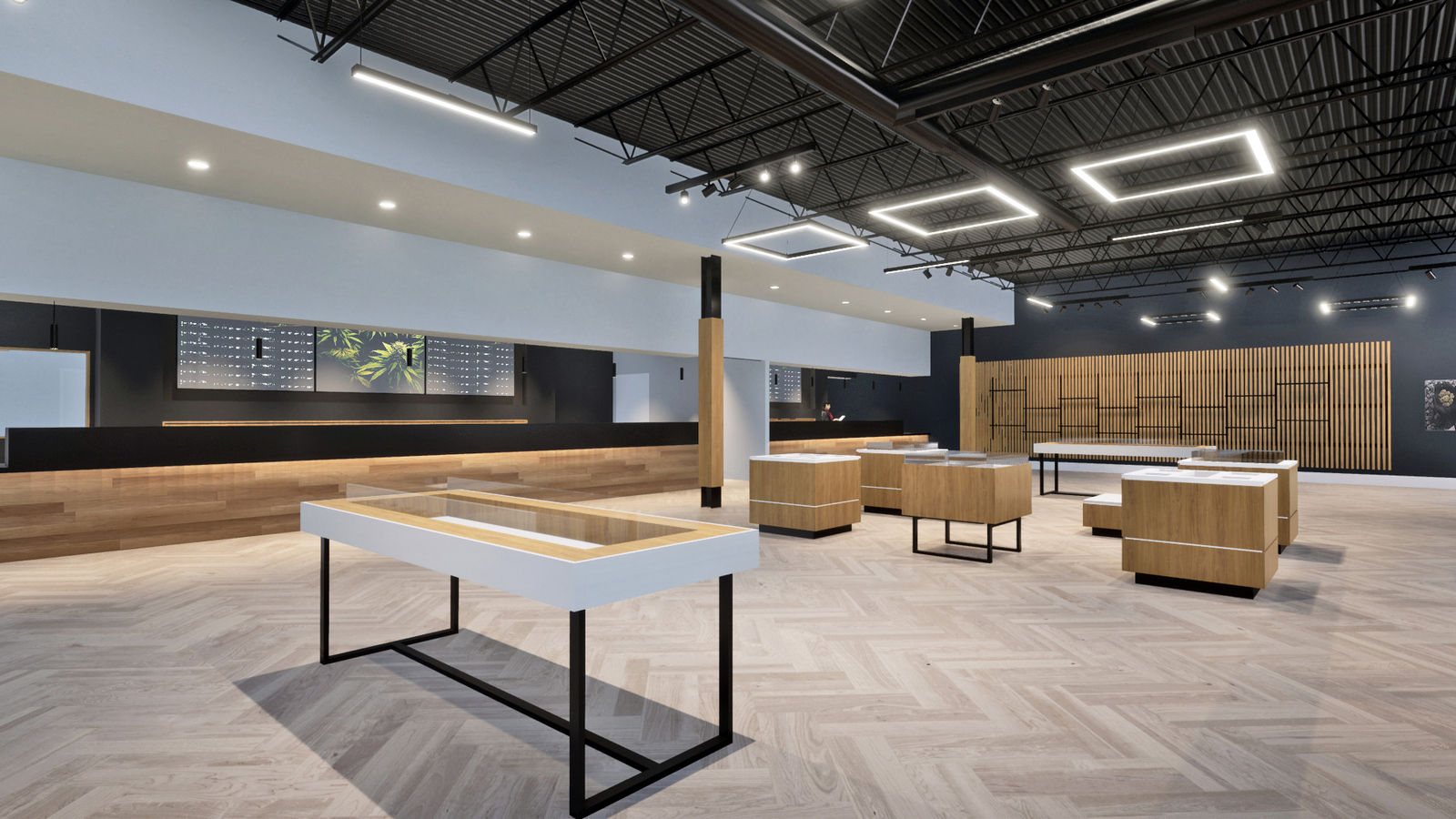ARCHITECTURE IS FOR EVERYONE—EVEN CANNABIS CLIENTS WITH NO TIME
Design can be a unique outlet for establishing and elevating a cannabis company in the public eye. But when faced with hard deadlines driven by unrealistic project schedules, where does design fall in a long list of business priorities?
Processing, cultivation, and dispensary spaces each contain unique problems to be solved and challenges to address. As an architecture firm, we are more than familiar with these distinct obstacles, and we’ve learned and adapted our practices as we’ve immersed ourselves in the cannabis sector, working closely with facility owner-operators and investor groups to meet their deadlines while delivering memorable spaces.
So, what have we learned along the way?

Dispensary
- Leverage Existing Building Assets
It’s faster. It’s more efficient. And ultimately, architecture of place is important. By tapping into existing elements of a building, you boost its familiarity in the community—and maximize its future potential. - Secure Your Loading Approach
Whether you’re managing product and earnings transportation via a fenced area or by pulling vehicles inside, you’ll want to keep security front of mind. Yes, you may need to sacrifice space—but peace of mind is worth it. - Consider Coiling Security Gates
There’s a lot to be said for perceived security—but the investment in coiling security gates can be significant. Consider your neighborhood. Consider the preferences of local officials. And ultimately, know that the vault is your biggest attribute when it comes to security.
A few other basic security tips: Maximize your sight lines. Avoid hidden corners or blind spots, even when it comes to landscaping. And of course, elements like controlled entry, cameras, and additional security measures may be part and parcel for your local jurisdiction. Bring a trusted security specialist to the table—their expertise can make all the difference.

Processing
- Understand Fire Separations at Tenant Dividing Walls
There are strict fire requirements here—and they can get complex. Whenever possible, incorporate a C1D1 extraction booth to mitigate risk. But be prepared for the resulting nuances of power, sprinklers, and ideal placement. - Optimize Your Generator Location
Don’t save the generator for last. By planning for backup power early and intentionally, you can mitigate potential complications later. Don’t forget proper ventilation to shore up operations no matter the mitigating conditions. - Combine Security for Pedestrians & Vehicles
Consider syncing your security measures for pedestrians and vehicles with one shared entrance. It’s more efficient and reduces the need for duplicate corridors or security checkpoints—which ultimately reduces costs.

Cultivation
- Incorporate Insulated Metal Panels (IMPs) for Grow Rooms
IMPs are a great way to ensure high-quality environmental control—and their standard sizing means you can easily scale. Just keep corresponding elements like fans, lighting, and CO2 detection in mind when setting ceiling heights. - Moderate Your Building Heating Ventilation and Air Conditioning (HVAC) Controls
Grow room climate management is critical to room yields, and it’s one of the toughest things to dial in. Focus on temperature and relative humidity—and do your research on the best system to manage fluctuating conditions. - Carefully Coordinate Your Vendors
With long lead times, urgent schedules, and the nuanced stacking of trades, meticulous coordination has never been more important. The use of a singular architect to spearhead design and manage your complex team of engineering consultants can streamline communications and help meet your aggressive schedules. The more you can achieve flow and effective staging, the faster you’ll be growing. - Know Your Jurisdiction’s Position on Floor Drain Waste
The Authority Having Jurisdiction (AHJ) sets standards on floor drain waste, and these codes can vary depending on where you are. Do your research on your particular building regulations. Plan your drainage needs accordingly. - Don’t Phase the Work If Possible
Yes, there are always mitigating circumstances. But we’ve seen time and again the benefits of planning and building your whole project within one scope. Resist the temptation to slice things up—you’ll save time and money in the long run.

General
- Don’t Shirk on Due Diligence
We like to say, “Hire your architects early and often.” Get everyone involved from the onset, because inevitably each vendor’s needs, wants, and schedules will coincide or conflict with others—and it’s better to know this early. - Consider Laser Scanning
If possible, use laser scanning to understand your existing building conditions. It’s an invaluable tool for architects and engineers to have a more precise understanding of what they’re dealing with at the starting line. - Manage Your Utility Services & Lead Times
Many utilities aren’t particularly customer-friendly, so you’ll need to be dog-headed to figure out what new utilities or services you’ll need and dig into them as early as you can. Everything always takes longer than you think. - Coordinate Your Structural Priorities
Coordinate with structural engineers to get a handle on what new loads are possible with an existing building. Working with partners helps you get to know things like the weights of equipment on the roof, how many plants, etc. - Consider a Building Condition Assessment Report
Another invaluable evaluation tool: a Building Condition Assessment Report. This goes hand-in-hand with structural analysis and helps you understand what’s possible with the existing space—so you can get a comprehensive look early on.
Chris Dawson Architect (CDA) is a design-driven firm based in Pennsylvania that has completed dozens of cannabis facility design projects across 11 states (and counting)—often at the request of existing clients whose positive experiences led us to secure licenses in other states. We’ve tackled new ground-up constructions. We’ve handled existing building conversions. From warehouses to automotive repair shops and everything in between, no opportunity has gone unexplored when it comes to potential project sites.
Since our first project in this space, our clients have appreciated our technical competence, responsiveness, attention to detail, and unwavering commitment to their success. Our goal is to create a collaborative and thoughtful experience for our clients all the way to the project’s completion.
